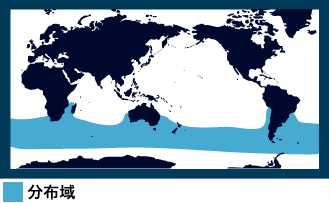- TOP
- ECOLOGY
- Cetaceans Around the World
- Encyclopedia of the Whales
Baleen Whales
ヒゲクジラの仲間
 Blue whale
Blue whale

シロナガスクジラ
Blue whale
ナガスクジラ科/Balaenoptera musculus
Maximum length: 33 m
Blue whales are the largest animals on earth. Their bodies are bluish gray with either light or dark dots. They have extremely small dorsal fins on their lower backs and short, pointy pectoral fins are characteristic of them.
They are found in waters 80-3,700 m deep all over the world.
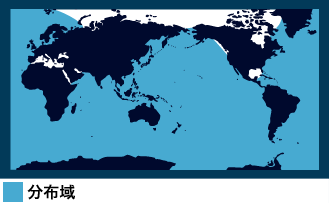
 Fin whale
Fin whale

ナガスクジラ
Fin whale
ナガスクジラ科/Balaenoptera physalus
Maximum length: 27 m
Fin whales are the 2nd largest cetaceans, but they have slender bodies. Most of them have asymmetrical coloring on their heads and upper bodies, and their right sides are light gray. Their beaks are slim, and each side of their upper jaws has 350 to 400 baleen plates.
They can be found all over the world from equatorial regions to the polar regions.
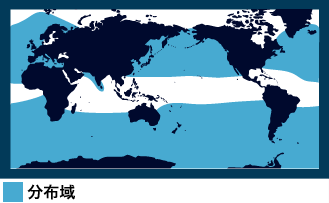
 Sei whale
Sei whale

イワシクジラ
Sei whale
ナガスクジラ科/Balaenoptera borealis
Maximum length: 18 m
Sei whales are said to be “the most beautiful whales” because of their slender bodies and size. Their hooked dorsal fins are straight and large, and they are positioned three fourths of the way back from their mouths. Their heads are a narrow V shape with a ridge.
They can be found in all of the oceans around the world except for the North Indian Ocean.
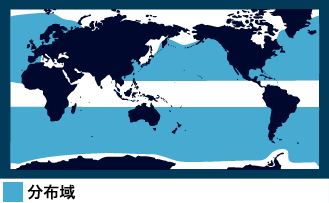
 Bryde's whale
Bryde's whale

ニタリクジラ
Bryde's whale
ナガスクジラ科/Balaenoptera edeni (Balaenoptera brydei)
Maximum length: 15.5 m
Bryde’s whales have slender bodies. Their backs and the area around their pectoral fins are dark gray, while their bellies are lighter. The three ridges that run from their mouths to their blowholes are characteristic of them.
They are found in coastal and offshore areas of temperate and tropical waters mostly between 40 degrees south and north latitude.
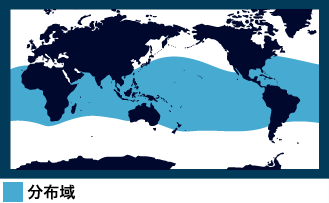
 Eden's whale
Eden's whale

カツオクジラ
Eden's whale
ナガスクジラ科/Balaenoptera edeni
Maximum length: Lack of data
Eden’s whales had formerly been considered to be the same species as Sei whales and Bryde’s whales, but when Bryde’s whales were recognized as being different from Sei whales, they were then recognized as being different from Sei whales too. Afterwards, differences in the skull were discovered between Bryde’s whales and Eden’s whales, so they were categorized as a different species.
Although they are normally found in coastal waters, different populations are said to exist in separate regions, and their distribution is unclear due to a lack of data.
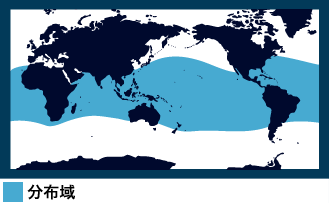
 Omura’s whale
Omura’s whale

ツノシマクジラ
Omura’s whale
ナガスクジラ科/Balaenoptera omurai
Maximum length: 11 mOmura’s whales have recently been recognized as a new species. Although they resemble Bryde's whales, they only have one ridge on their heads, while Bryde’s whales have three ridges. Their coloring is asymmetric with their heads being white on the right side and grayish black on the left side. Their dorsal fins have a hooked shape.
Their distribution is still unclear due to lack of data.
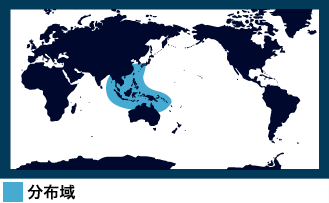
 Common minke whale
Common minke whale

ミンククジラ
Common minke whale
ナガスクジラ科/Balaenoptera autorostrata
Maximum length: 10.7 m
The smallest of the Rorquals, common minke whales are almost 1/3 of the size of fin whales. They have small, compact bodies with sharp heads and white marks on their pectoral fins which are characteristic of them.
They are found in open waters, coastal waters, continental shelves, and around islands all over the world.
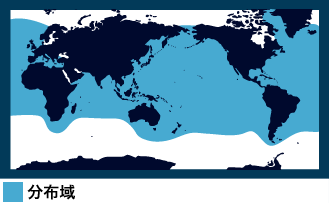
 Antarctic minke whale
Antarctic minke whale

クロミンククジラ
Antarctic minke whale
ナガスクジラ科/Balaenoptera bonaerensis
Maximum length: 10 m
Antarctic minke whales are the smallest species of Rorqual, and they rarely grow beyond 10 m in length. Their backs are dark gray while their bellies are white. They have distinctive bright gray, wavy lines across their sides.
They are found between the equatorial regions and the Antarctic Ocean.
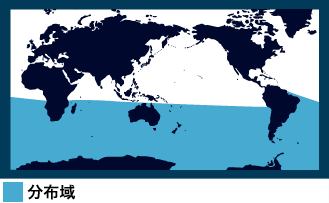
 Humpback whale
Humpback whale

ザトウクジラ
Humpback whale
ナガスクジラ科/Megaptera novaeangliae
Maximum length: 16 m
Humpback whales have large bodies with very long pectoral fins and small, low dorsal fins that look like humps. They have “humps” on their heads, lower jaws, and along the lines leading to their pectoral fins.
They are found in all major oceans.

 Gray whale
Gray whale

コククジラ
Gray whale
コククジラ科/Eschrichtius robustus
Maximum length: 15 m
Gray whales have strong, large bodies with narrow heads that look triangular from above. Their tails have a series of humps. Their characteristic coloring is dark gray with white and orange spots all over.
They are found in shallow, coastal waters in the Pacific Ocean.
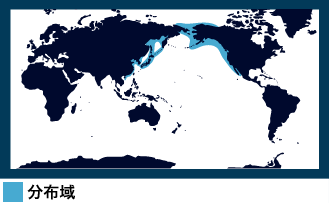
 Pygmy right whale
Pygmy right whale

コセミクジラ
Pygmy right whale
コセミクジラ科/Caperea marginata
Maximum length: 6.5 m
Pygmy right whales are the smallest of the baleen whales, and their backs are dark gray with light gray bellies. Small dorsal fins positioned on their lower backs and their arched mouth-lines are characteristic of them.
They are found in temperate waters around Antarctica, and they are rarely observed alive.
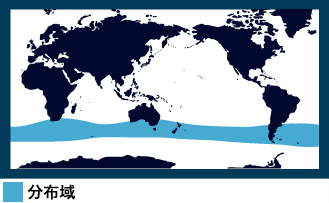
 Bowhead whale
Bowhead whale

ホッキョククジラ
Bowhead whale
セミクジラ科/Balaena mysticetus
Maximum length: 20 m
Bowhead whales have heavier and more robust bodies than the similar North Pacific right whale with larger heads that have a bulge at the top. A large, arching mouth-line and the white spots at the tip of lower jaws are their prominent characteristics.
They are only found in the Arctic Ocean.
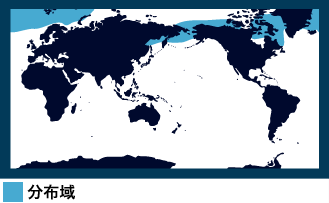
 North Pacific right whale
North Pacific right whale

セミクジラ
North Pacific right whale
セミクジラ科/Eubalaena japonica
Maximum length: 18 m
North Pacific right whales have stout but tapered, black bodies, and they lack dorsal fins. Their pectoral fins are square. They characteristically have large, arching mouth-lines and white spots on their heads. “Callosities” are observed in right whales around their eyes, lower jaws, or on their heads.
They are only found in the Sea of Okhotsk, the Bering Sea, and the Gulf of Alaska.
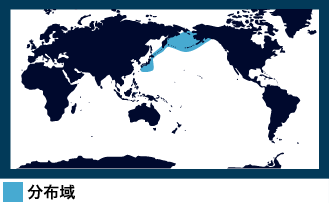
 North Atlantic right whale
North Atlantic right whale

タイセイヨウセミクジラ
North Atlantic right whale
セミクジラ科/Eubalaena glacialis
Maximum length: 18 m
North Atlantic right whales have stout bodies, and their wide, smooth backs lack a dorsal fin. Their mouth-lines are large and arching, and they have square pectoral fins and white spots on their heads which are characteristic of them. They resemble North Pacific right whales and Southern right whales.
They are found in the waters between Florida and the coastal shelves of eastern Canada.

 Southern right whale
Southern right whale

ミナミセミクジラ
Southern right whale
セミクジラ科/Eubalaena australia
Maximum length: 18 m
Southern right whales have stout, smooth, black bodies. Together with large, arching mouth-lines, square pectoral fins, and white spots on their heads, they resemble the North Pacific right whale and the North Atlantic right whale.
They are found in all regions of the Southern Hemisphere.
